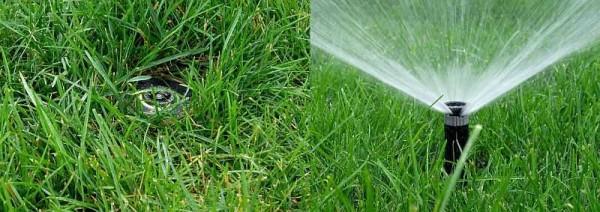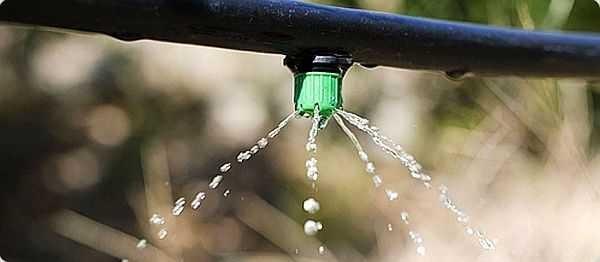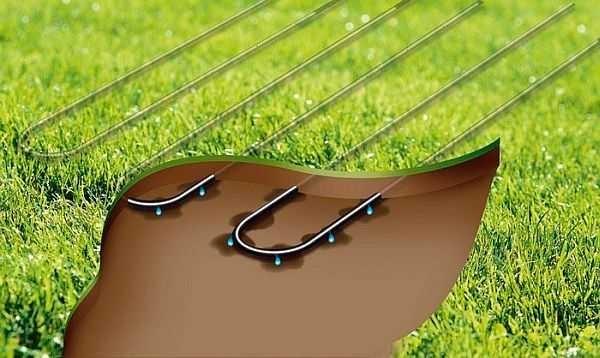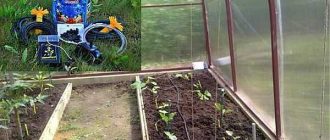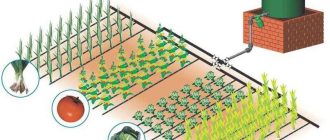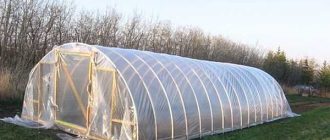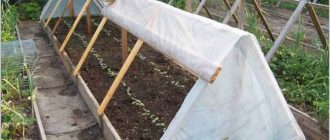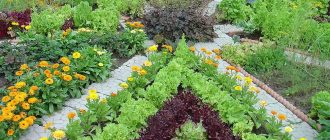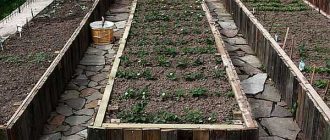Taking care of the area around the house – vegetable garden, greenhouse, garden, lawn, flowerbeds – takes a lot of time and effort, and watering is a major hassle. If it is automated and forces and time will take less, and the result will be better: less water will be used, yield and appearance of plants will be better. It’s all about regularity and uniformity of watering. Develop such systems specialized firms, but automatic irrigation can be done with their own hands.
Isi artikel
Types of automatic irrigation systems
Watering in automatic mode can be planted in any way: in the open ground, in the greenhouse, even on the balcony or on the windowsill. It is just that the scale and methods will be different. Water can be supplied in several ways:
- Sprinklers. Through special devices, water is sprayed over the surface, simulating rain. This method of automatic irrigation is most often used to irrigate lawns. Grass responds well to surface water application. Application to other plantings may be limited due to the possibility of disease development.
- Drip root irrigation. In this case, water is brought to the planting area and delivered in drops, sometimes in thin streams, to the area where the root system of the plant is located. This method of automatic irrigation is used for vegetable and berry crops, trees, shrubs, flowers. It is often installed in greenhouses, vegetable gardens, flower beds. Miniature systems can be made on the balcony or for home flowers. Because the water is supplied exactly where it is needed, such irrigation is called “spot”.
- Underground water application. Underground water supply is mainly organized by drip technology. Hoses differ – they must be more durable, have the features of the drip: in the composition of the material from which they are made, introduce herbicides that do not allow plant roots to clog the exit holes. In all other respects, the structure is similar.
Despite the different ways of supplying water, the system of automated irrigation itself is built in the same way according to the same principles. They differ in operating pressure: drip water supply can work even in gravity systems with low pressure – from 0.2 atm, for sprinklers-sprinklers pressure must be greater. Accordingly, the components of the irrigation system and its connections must be designed for different operating pressures. There are no other differences: the layout is the same.
Principles of construction
The principle scheme of automatic irrigation is briefly as follows. There is a source of water, from him on the site to the irrigation zones divorces the main pipeline. Further, with the help of tees, crosses, small-diameter pipes and water supply devices, the irrigation system is created. For the normal operation of the nodes of the water outlet filters are required, they are put on the main water pipeline. That’s all. All the rest – the particulars. Even the pump or control system can be, and you can do without them
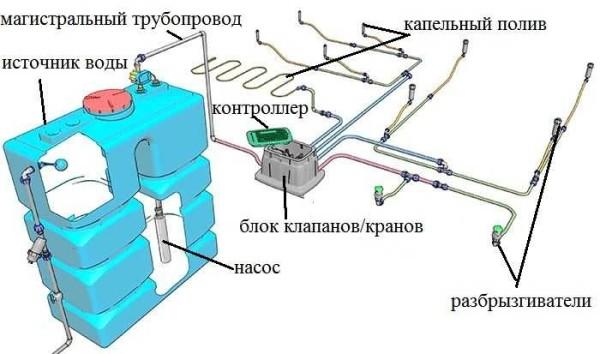
How to organize water supply to the house from a well or a well read here.
How it is controlled
Manage irrigation can controller (automation unit) or a person by turning the faucet. If the controller is installed, the system is almost fully automated: it turns on and off the water supply at a given time. There are devices with a very high degree of automation – they monitor the weather, soil moisture and in accordance with these data adjust the work of the equipment. In the simplest version of the irrigation automation at a given time supplies water, after a certain period of time (set in the settings) it turns it off.
If there is no irrigation controller, open the water supply and stop it need a person. But this is all that is required of you, everything else will do the irrigation system.
Water flow and irrigation intensity
Since the flow of water through the distribution points is mostly rationed, it is possible to determine with a fair amount of accuracy how long the watering should last, so that the water is not too much and not too little. If all the plants to be watered require the same amount of water, there are no problems, but this is not always the case. This is the case with a lawn, sometimes there are extensive plantings of the same plantings in the vegetable garden or in the garden. But more often there is a situation where some plants are more water-loving and others less so. This problem can be solved in several ways:
That’s why automatic watering with your own hands and can be done: you have a lot of opportunities to achieve the desired result.
Where to take water from
The source of water for an automatic irrigation system can be a water pipeline, a tank with pumped water, a well, a well, a river, a lake. In all cases, filters are installed on the main pipeline. It’s just that different sources require different equipment. If water is pumped from an open source (river, lake), be sure to put first a coarse filter, then a fine filter. In all others (except for drinking water supply) put only equipment for fine purification.
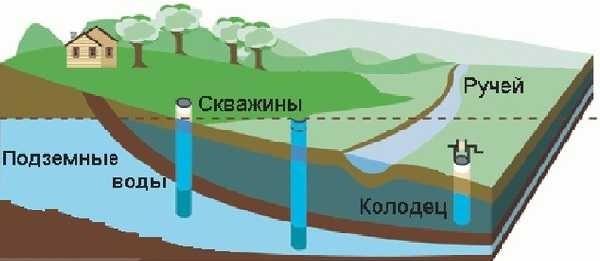
If we are talking about automatic watering of a vegetable garden or greenhouse, then it is definitely better to first pump water into a container, where it will heat up, and then distribute it to the site. For dachas and homestead plots, there are a number of systems that work practically by gravity. They need a minimum pressure, which is created by lifting the container to a height of about 1-2 meters. There are systems that can work if the tank is raised to 10-40 cm above the ground (this system of drip irrigation AquaDusya, Vodomerca and others, you can read about them here).
With this organization – with a tank for water – pump for automatic irrigation system can choose any. Only if he could periodically pump water into the tank. The water level in the tank is most often controlled by a float mechanism (like the one in the toilet cistern). In this case, do not forget to provide an emergency overflow and take it out to some source, otherwise your plot may turn into a swamp.
If the source is used as a water supply – centralized or not, and irrigation is selected drip, you need a reducer, reducing and stabilizing the pressure in the system, since most of this equipment can operate at a pressure of no more than 2 atm.
Schemes of automatic irrigation
Options and variations of schemes are numerous. They are very mobile and allow you to take into account all the features of sites and plantings. Consider the case when water is supplied from the source with the help of a pumping station immediately for watering plants. Such a variant of automatic irrigation is shown in the photo below.
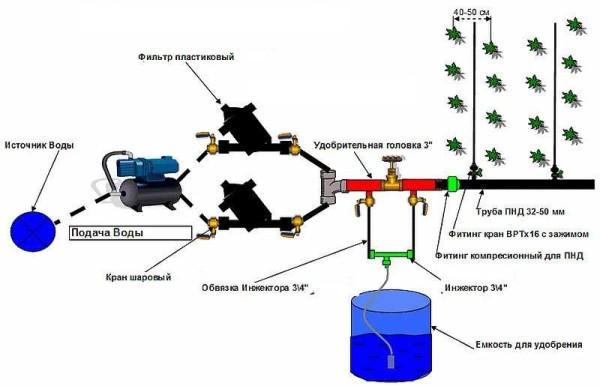
Water to plants can be supplied by drops or with the use of sprinklers. There is a node of fertilizer application. It will come in handy in the system of auto irrigation of the vegetable garden, greenhouse or garden, although for the lawn and garden, too, will not be superfluous. The number of irrigation lines is determined depending on the need, then the pressure is calculated. Droppers or sprinklers are selected according to the amount of water needed for plants.
The scheme of the automatic irrigation system with the use of sprinklers is shown in the photo below. These devices have several names: sprinklers and sprinklers, because of which irrigation is called “sprinkler”.
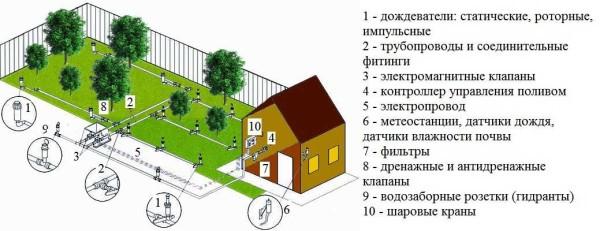
The main difference between lawn irrigation systems is that the pipelines are more often laid underground. In order that the sprinklers do not interfere with lawn mowing, they should also be hidden in the ground. There are such models.
The scheme of automatic irrigation of a vegetable garden, greenhouse and garden is shown in the figure below. Water is first pumped into the tank. From there it can be fed by gravity, if the water supply is dripping (it is drawn). To ensure the required pressure for sprinklers, a pump or pumping station will be needed.
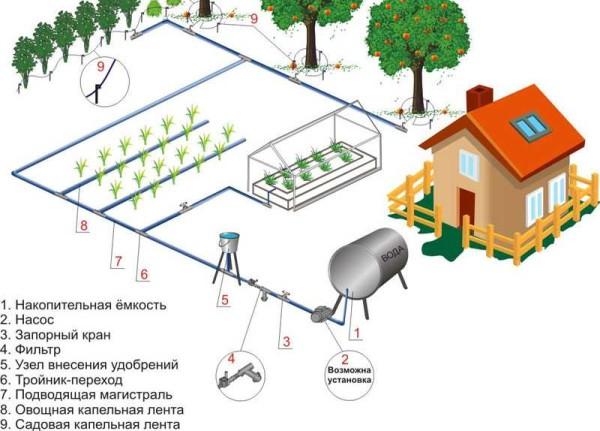
If a vegetable garden, garden or greenhouse needs to provide moisture, arrange everything as in the picture below. From that top it differs by the presence of a pumping station that feeds water to the filters, after which the pipeline is already dispersed to the beds.
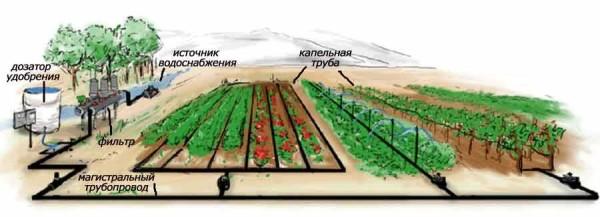
The order of actions when developing an irrigation system with your own hands
First, take a site plan in scale. If it is not ready, draw on a millimeter or a large sheet in a cell. Apply all the buildings, beds, large plants.
Development of the configuration
On the plan you draw irrigation zones, the source of water, its location. Alongside draw how the main pipeline will pass. If you are going to sprinkle sprinklers, draw the zones of their action. They should overlap and there should be no unwatered areas.
If the plantings are planted in rows, it is more rational to use drip irrigation: water consumption is much less, as well as the cost of equipment. When designing a scheme with drip irrigation, the number of irrigation lines depends on the distance between the rows. On the rows between which the distance is greater than 40 cm, one line is needed for each. If the rows are located closer than 40 cm, watering is carried out in the inter-row and lines are obtained by one less.
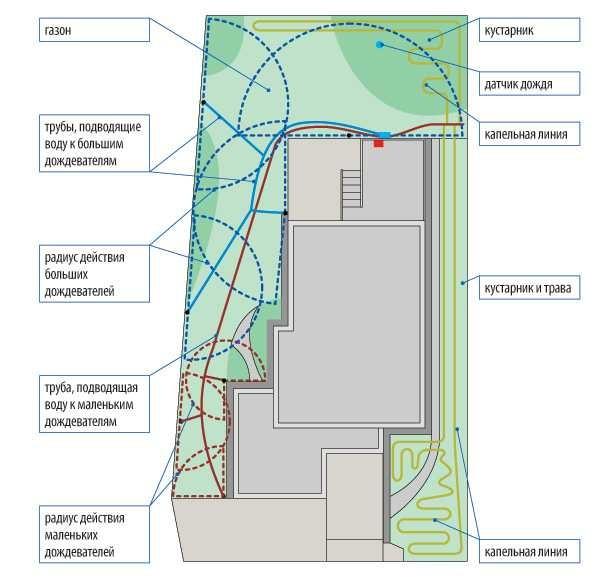
After all the sites are drawn, determine the length of the required pipelines, count how many and what points of water distribution you got, determine the equipment – the number of pipes, hoses, tees, drips, sprinklers, whether or not you need a pump and reducer, will be installed tank or not, what automation should stand and where. Here after all this is already thought out, down to the diameters of pipes, fittings and adapters, comes the practical stage. Irrigation system, drawn on paper begins to materialize on your plot.
Beginning to build
Next comes the construction work. And the first thing you need is to decide how you will lay the pipes. There are two ways: lay the pipeline on top or bury it in a trench. On the ground usually laid on the dacha: here irrigation is seasonal and in the fall it is dismantled. Very rarely irrigation systems in dachas are left for the winter: even if the equipment can withstand the winter, it can simply break or steal.
When creating a system of automatic irrigation of the site of the house of permanent residence, try to make everything as inconspicuous as possible, because the pipes are buried. In this case, dig trenches with a depth of at least 30 cm. This depth is enough so that the pipes are not damaged during excavation. Just do not forget that pipes, fittings and other equipment that remains winterized, must tolerate freezing.
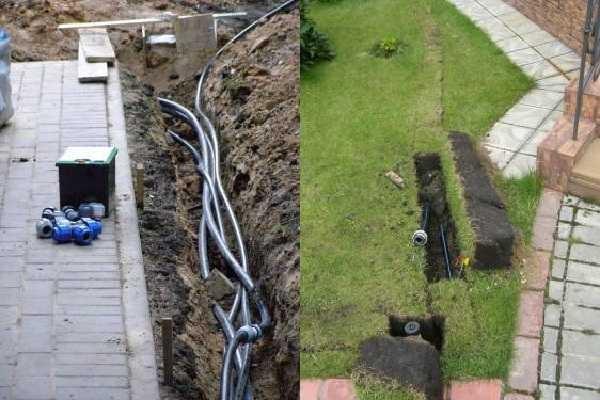
From the main water pipes branch off to irrigation. All nodes and connections should preferably be made in hatches with covers: it is in the connections, tees, etc. most often occur leaks. Digging the entire trench to find the place of leaks – not the most fun occupation, and if all the “problem areas” are known in advance and relatively accessible, maintenance becomes an easy task.
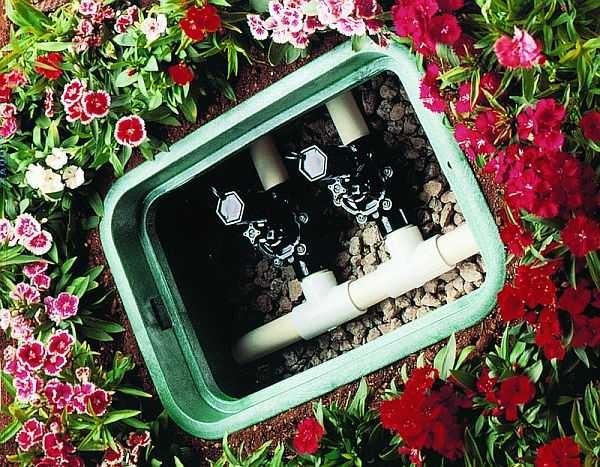
The last stage – depending on the chosen method of irrigation in the hoses are installed water distribution devices, everything is connected and tested.
Accessories
Piping on the site is made of polymer pipes. They are resistant to corrosion, do not react to most fertilizers, reliable, easy to install (there are ways of installation without any special devices). Most often HDPE (low-pressure polyethylene) pipes are used. To all the previously described pluses is added resistance to ultraviolet light: they can be laid on the surface. Also suitable are LDPE (high-pressure polyethylene), PVC (polyvinyl chloride, but it is afraid of ultraviolet) and PPP (polypropylene, its disadvantage – you need to connect by welding and disassemble impossible).
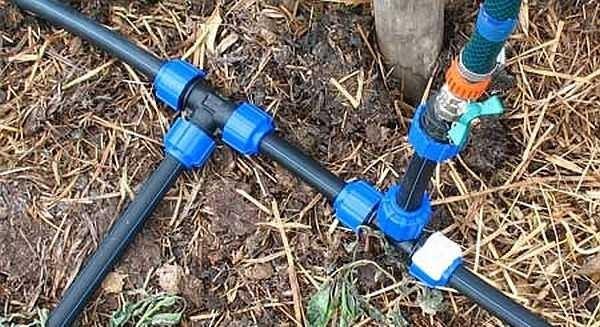
For automatic irrigation systems for dachas, greenhouses and vegetable gardens take mainly pipe 32 mm in diameter. If you are going to water a large number of beds, it is better to take the size of a step larger – up to 40 mm.
HDPE pipes are assembled using compression fittings (with gaskets on the thread). They withstand the pressure in the water pipes of multi-storey buildings, so the pressure for irrigation will withstand exactly. Their plus: at the end of the season, they can be unwound, all dismantled, and next year use them again.
If drip irrigation is chosen, drip hoses or tapes can be connected to the main line, it is possible to mount drippers on ordinary hoses (make a hole and there insert a small-sized device). When irrigating by sprinkling, sprinklers are installed. They have a different structure and cover areas of different shapes and sizes – round, sectors, rectangular.
About the types and kinds of accessories for automatic irrigation is well told in the video from one of the market leaders of irrigation systems of the German company Gardena (Gardena). Their equipment is of high quality, but the prices are very high.

